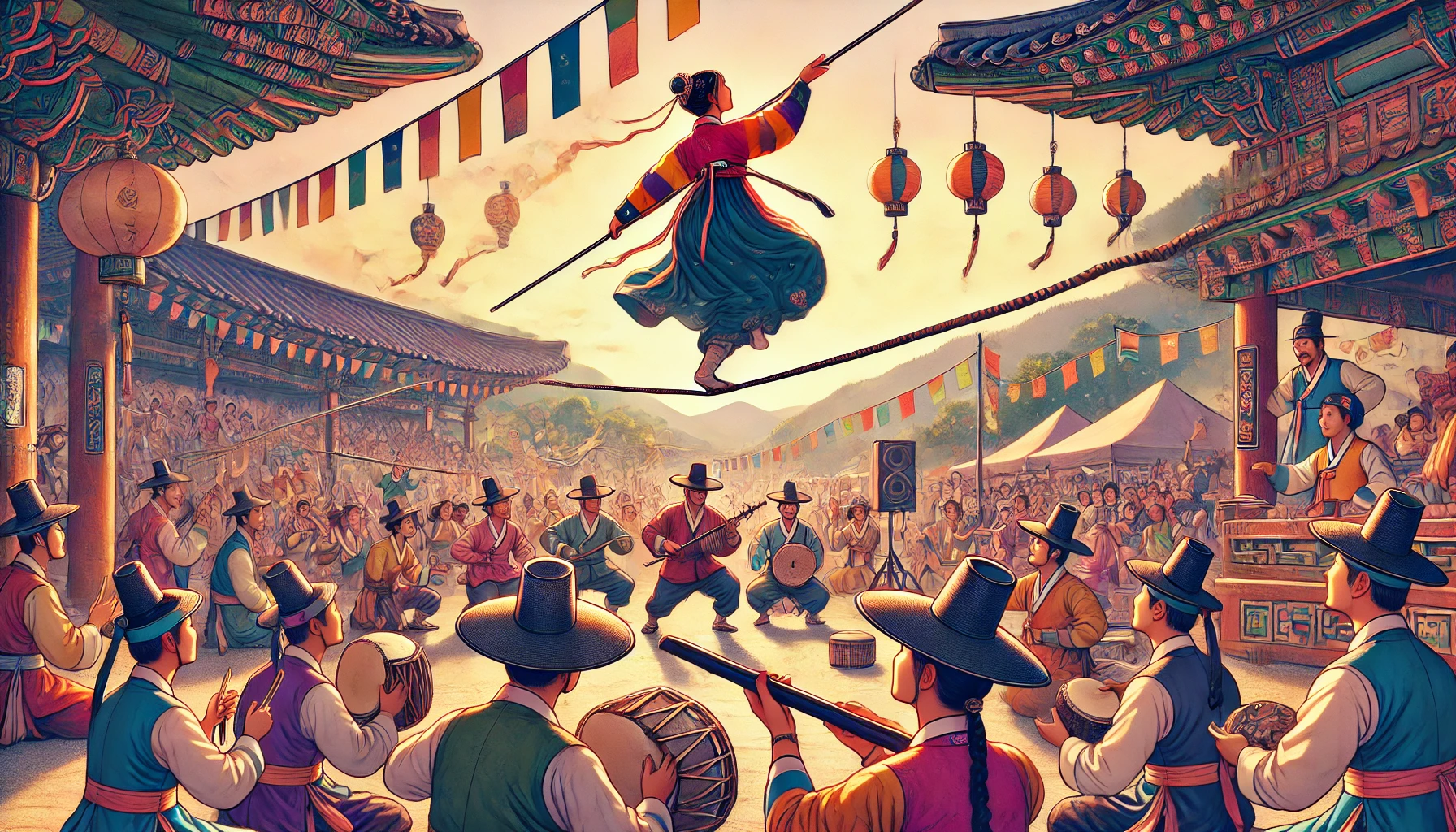Tightrope walking in Korea is an interdisciplinary art in which tightrope walkers, clowns, musicians, and spectators perform together in a cycle of tension and relaxation. In this process, spectators are transformed from mere observers to participants, and tightrope walking plays an important role in conveying social messages and preserving and rediscovering traditional culture.
Tightrope walking in Korea is a multidisciplinary art that energizes the performers, clowns, musicians, and spectators as they interact with each other, sharing the woes and joys of life. It is performed by performing acrobatics, jokes, and songs, and depending on the dramatic situation, the audience may also participate.
In addition to performing tricks in the limited space of the tightrope, the clown also exchanges jokes with the clowns, musicians, and spectators on the ground below the tightrope. This form of performance is three-dimensional in the sense that it vertically expands the dramatic space from the horizontal space of the rope, where the clown is on, to the space where the audience is located. This gives the audience the experience of being part of the performance, rather than just watching.
Tightrope walking has a repetitive structure of tension and relaxation. In general, the whole process of tightrope walking goes something like this: tightrope examination – skill I – play – skill II – wrap-up. First, the performance begins with a test to wish all the participants happiness, followed by the performance of the first skill. The tension of the audience gradually builds as the clowns perform breathtaking tricks on the ropes. The tension created by the first act is relieved by the subsequent acts, which are centered on jokes and songs. The ‘Jungnori’, which satirizes the dynasty, and the ‘Walzanori’, which caricatures various classes of people, provide dramatic interest and relax the tension created in the first part. The audience’s tension is further heightened during the second act, which consists of more difficult tricks. The peak tension is gradually released during the finale, bringing the entire act to an end. In this way, the tension and relaxation of tightrope walking is repeated in each process, increasing the dramatic immersion of the spectators and multiplying their interest.

Meanwhile, the repetitive structure of tension and relaxation throughout the entire tightrope walk is also applied to each part of the tightrope walk. For example, Gije II is composed of exquisite skills such as the “angangjang,” which involves walking while hopping on only one foot, and the “ship mast stand,” which involves standing upside down with both legs attached. Interspersed between the skills are witticisms, as well as intentional distortions and mimicry of the characters’ appearance and behavior. The tension created by the difficulty of the performance is relieved through a series of audiovisual attractions.
In this way, Tightrope realizes the life and death of the people through the repetitive structure of tension and relaxation. The repetitive form of tension and relaxation symbolizes the bend of life as well as the providence of nature, and therefore, tightrope walking has a more fundamental artistic value. In this sense, tightrope walking is not just a technical skill, but an important traditional art with social and cultural significance.
In particular, tightrope walking serves as an important medium to convey social messages during the performance process. Tightrope walkers and clowns communicate with their audiences by satirizing or criticizing social issues of the time through their wit. In this process, the audience is transformed into active participants rather than mere spectators, and the performance becomes more lively.
Tightrope walking is also important as a traditional art that is passed down from generation to generation. Even in the modern world, tightrope walking performances can be found at various festivals and events, serving as a way to rediscover and preserve traditional cultural values. These cultural values make tightrope walking more than just a performance art, but an important means of identifying and strengthening one’s identity as a member of a community.
In conclusion, Korean tightrope walking is a multidisciplinary art with social and cultural significance that goes beyond mere skill or performance. Through its repetitive structure of tension and relaxation, it plays an important role in engaging audiences, conveying social messages, and perpetuating traditions. In this sense, tightrope walking is an important part of Korean culture and is highly valued.
